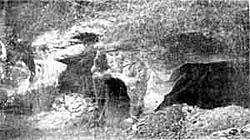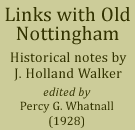< Previous | Contents | Next >
Caves in the Church Cemetery
 |
THE caves of Nottingham have never been properly studied and planned, and this is a great pity.
They are due to the soft nature of the sandstone upon which so much of Nottingham stands, and which is so easily excavated that all through the ages our forefathers have dog for themselves caves which they used as dwellings, as warehouses or as cellars, with the result that parts of Nottingham are honeycombed with rock-hewn passages and chambers, the thorough exploration of which would, if it were possible, lead to some very astonishing results.
These caves are of all sorts and sizes, some simple hollows like the well-known ones in the Church cemetery, others elaborately carved and decorated. They are of all ages, and unless they happen to contain relics it is hard to assign a date to many of them, or to say to what uses they have been put.
These caves had a great deal to do with the early commerce of Nottingham, for the first trade that we know to have developed here was that of brewing. Barley was obtained from the Vale of Belvoir, and the natural water of Nottingham was rich in gypsum. The beer brewed was matured in the caves which were neither cold in winter nor hot in summer, with the result that the fame of Nottingham beer spread abroad, and great quantities were exported throughout Mercia by our Saxon forefathers.
The caves at the top of Drury Hill played on important part as hiding places in the early days of Nonconformity, and during the religious persecutions during the later Stuart period, and many interesting and exciting stories are told relating to them. One relates how certain men were lost for a day and a night in the huge cave which still exists underneath Mansfield-road and Sherwood-street!
